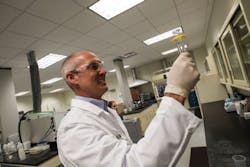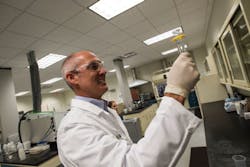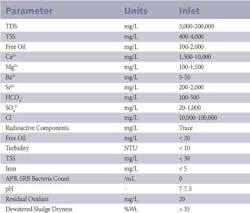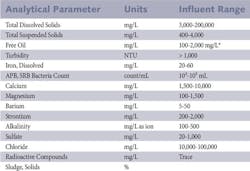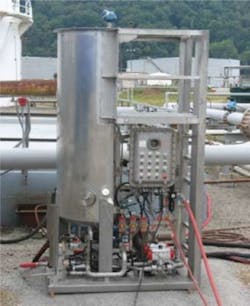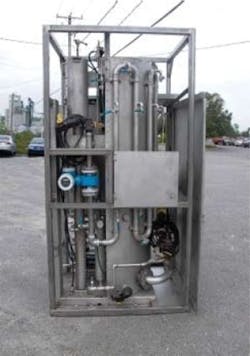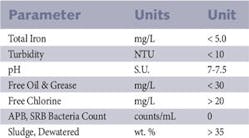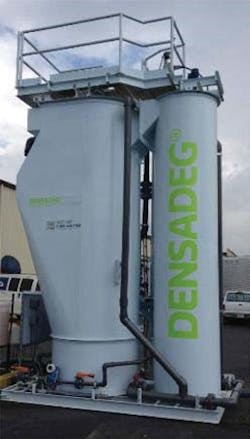In British Columbia, compact high-rate technologies for flowback/produced water treatment were recently tested that can effectively allow the producer to treat and reuse through a centralized “water hub” to lower the cost of water supply and waste disposal while enhancing environmental stewardship.
By Sreekumar Janardhnan
Water greatly impacts the bottom line of almost all hydraulic fracturing operations in North America. The cost of managing water, from sourcing fresh water to transporting wastewater away for disposal, has become an increasing and even dominant share of today’s fracking operations.
This is especially true in Western Canada’s liquids-rich Montney shale play. Output from the Montney formation, which encompasses 130,000 square kilometers from northeast British Columbia into northwest Alberta, has doubled since 2012 and today comprises a third of Western Canada’s natural gas production.
Drilling and completing a well in this formation can require up to 500,000 barrels (21 million gallons) of water, and wells can produce significant volumes post-completion, introducing up to 80 percent of the injected water back to the surface. Producers working this unconventional play are particularly constrained by limited access to fresh water sources and distant disposal wells for transporting flowback/produced water.
Although reusing water from fracking activity can prove less costly over the long term and is far more environmentally beneficial, approximately 80 percent of well fields simply inject or truck away their waste.
This is changing, however. Some producers are planning ahead, researching and testing new ways to bring down costs and at the same time handle their wastes in a much more environmentally-beneficial manner.
Due to the recent introduction of compact, high-rate water treatment technologies, along with the high potential incentives provided by unconventional assets such as in the Montney formation, some forward-thinking producers are looking toward flowback/produced water reuse in a big way.
Reuse: An Effective Mechanism for Cost Avoidance
Treating and conditioning flowback and produced water for reuse for wellsite operations provides a mechanism for cost avoidance by significantly reducing the cost of water supply and reducing the disposal components of water management. Not only does water reuse make projects more environmentally beneficial, it can make them more cost-effective and more competitive for capital funding.
In the Montney region, one producer recently pilot tested a flowback/produced water treatment process that can effectively allow for the development of a “water hub” to significantly lower the cost of water supply and waste disposal. This centralized facility approach would provide a closed-loop water management cycle, making the producer well positioned for full field development by allowing for the effective ramping up of multiple rigs with all water management handled by a single facility.
The pilot scale study was conducted from August 2016 through October 2016 and executed by piloting teams from SUEZ in North America. The piloting was contracted to SUEZ on a turnkey basis, and SUEZ Treatment Solutions Inc. provided the pilot units, equipment start-up, daily operations, sample collection, and compiling and preparing the final pilot study report.
The project logistics, including mobilization, demobilization, electrical work, site supervision, safety, chemicals, and auxiliary equipment needs, were managed through a local contractor. The developer/producer assisted with the installation of secondary containment, tank farm, water supply and disposal, and general site supervision.
The Pilot Study: Overview
This sustainable developer intends to treat and recycle the flowback/produced water from all its current and future wells in the Montney. Water reuse is a key component of its unconventional oil exploration business model. The first step toward achieving this was carrying out a lab-scale study to establish process direction and treatment chemistry and determine the minimum water treatment level necessary for reuse (see Table 1).
For the initial part of the study, flowback/produced water from multiple Montney well sites was brought to SUEZ Innovation, Development and Advanced Services (IDEAS) Center in Richmond, Va., for lab-scale treatability studies. Table 2 provides an overview of the flowback/produced water chemistry. The main objectives were the removal of free oil and grease (O&G), removal of iron to an effective level, and substantial removal of TSS/turbidity and the sulfate reducing bacteria (SRB) count in the flowback/produced water.
A demonstration scale pilot was then conducted at one of the producer’s well sites based on the initial guiding chemical program from the bench-scale testing. The team tested two highly selective “fit-for-purpose” water treatment lines to recycle flowback/produced water to a level suitable for use in fracking fluid that could be scaled up in the field. One treatment line included a high-rate solids contact clarifier and the other employed a high-rate flotation process.
Investigating and evaluating innovative technologies through the pilot study provided the expertise and understanding of each element of the total treatment protocol. The pilot-scale technologies installed at the site were essentially one-tenth scale versions of a full-scale produced water treatment plant, allowing for the operation of a comprehensive process replicating full-scale operations.
High-Rate Vertical Oil/Water Separation
Oil and grease present in produced/flowback water includes free oil, dispersed oil (small oil droplets), and emulsified oil. The gravity oil water separator (used in both piloted treatment lines), separates free oil from water in a vertical, highly compact design.
Separated oil is evacuated from the unit via overflow and is segregated from the process water stream. The SUEZ poseidon® Vertical Oil Water Separator (VOWS) pilot unit is designed to treat a maximum flow rate of 22 gpm and has the same basic technical characteristics as a full-scale unit, allowing for a proper evaluation of the technology. Inlet and outlet samples were taken periodically during the trial to evaluate its performance and operability of the VOWS as well as all other process components.
The unit’s internal conical separation surfaces allow for the separation of smaller oil droplets, thus minimizing the unit’s footprint. Recovered oil is removed via overflow controlled by an interface probe that adjusts the level in the unit based on the layer of oil separated. Heavy material settles to a single bottom outlet, eliminating the need for internal moving mechanical components.
Microbubble Flotation Technology
After free oil and grease are separated from the water, flows then entered a skid-mounted SUEZ poseidon® Saturn™ Dissolved Air Flotation (DAF) pilot unit to remove dispersed and emulsified oil and other coagulated/precipitated matter. The DAF uses air to rapidly float out this oil and other matter. The density of oil particles is reduced as they attach to air bubbles, improving the speed of oil flotation to the surface.
Within the DAF unit the wastewater stream from the vertical oil separator is chemically conditioned before the coagulated/flocculated oil and solids are physically separated through flotation. The process employs targeted chemicals to precipitate oils and solids (TSS) out of suspension and a physical mechanism to remove those solids from the water. A portion of the DAF-treated water is sent to a recirculation pump and saturated with air to generate microbubbles sized to approximately 30 microns. This air-saturated treated water is continuously sent back to the inlet of the DAF in a recycle stream.
High-Rate Clarification/Thickening
In the other piloted configuration, following free oil and water separation, flows entered a SUEZ Densadeg® pilot system. The unit is a high-rate solids contact clarifier that combines optimized flocculation, internal and external sludge recirculation and plate settling in two conjoined vessels. The system provides all essential functions for complete clarification of water, thus providing a considerable reduction in footprint compared to conventional systems. This high-rate solids contact clarifier option can be highly effective in applications where the water treatment objective requires a chemical precipitation step.
Multimedia Filtration
After the primary and secondary removal of free, dispersed and emulsified oil and other coagulated/precipitated matter, flows then proceeded to a multimedia filter (MMF) containing sand media for final polishing prior to discharge. During the trial, backwashing sequences would automatically commence once filters reached an approximate 10 psi differential. The MMF was utilized during all treatment configurations tested over the entirety of the pilot plant study.
Solids Dewatering/NORM Protocol
Following treatment via the two piloted treatment trains, solids were dewatered on a belt filter press, with the solids then sent for disposal. Dewatering successfully achieved a solids content in the sludge greater than the treatment guarantee of 35 percent on the majority of measurements.
Through Naturally Occurring Radioactive Materials (NORM) radiation survey instrumentation counts per minute (cpm) readings, it was observed that the sludge generated in the pilot DAF contained a relatively high level of NORM. The main source of the NORM radiation came from the sludge blanket atop the DAF and the dewatered sludge cake from the filter press.
The piloting activity for this specific project enabled the team to develop a NORM management procedure and provided insight into NORM handling and management as it pertains to flowback/produced water reuse. The close collaboration between the pilot team members not only enabled the project to be compliant but also allowed for the development of protocols for certain aspects of the NORM regulation and helped establish a design basis for the commercial-scale plant.
Result: High-Rate Removal Efficiency
Both piloted treatment configurations met the treatment requirements set out by the producer/developer (see Table 3). During the trial, free chlorine levels (chlorine was selected for SRB disinfection) did not remain above 20 mg/L for either treatment process.
The removal efficiency of oil and grease in the VOWS pilot unit averaged above 91 percent, with peak performance above 99 percent for a number of days during the trial period. Overall, DAF proved to be the preferred treatment method during this study, with respect to operational efficiency and meeting treatment objectives. Due to the amount of oil and grease present in the produced water, the VOWS proved to be a vital component for both piloted treatment designs and played an integral part in the uninterrupted treatment of fluid containing significant oil and grease compounds.
Based on the performance of the system and ease of operation, and considering the current treatment objectives, it was determined that the compact oil/water separator and the compact flotation process will form the core process components in any potential treatment configuration. The other piloted configuration (involving Densadeg®) will be applied should there be a future need for partial softening of the water.
Conclusion
The treatment chemistry for this very high TDS (approximately 200,000 ppm) frack flowback/produced water was tested and established to meet the specific treatment objectives of the producer. A high-rate, compact treatment solution was developed and successfully tested in this demonstration scale pilot. This allowed for the full optimization of the entire process and has helped pave the way for the future successful long-term management of water resources by the producer.
Considering the high scaling and fouling potential of the water, developing chemistry and validating it at pilot scale was critical to lower the risk of proceeding with the proposed water hub project.
The producer has further gained significant knowledge in water management infrastructure that can allow it to more effectively facilitate produced water reuse in future asset development. Expanded use of these high-rate, compact de-oiling and flotation technologies, together with other responsible water management practices, will help enable the producer to deliver on future production targets.
About the Author: Sreekumar Janardhnan, Ph.D., P.Eng. is technology and marker leader in oil and gas for SUEZ in North America. He can be reached at [email protected].
